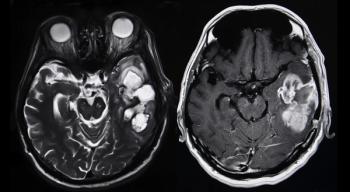
More than half of young adult cancer patients reported ongoing problems related to sexual function during the first 2 years after their cancer diagnosis.

Your AI-Trained Oncology Knowledge Connection!


More than half of young adult cancer patients reported ongoing problems related to sexual function during the first 2 years after their cancer diagnosis.

Use of two BEACOPP regimens that incorporated brentuximab resulted in improved rates of complete response and complete remission at the end of treatment.

Treatment with the anti–PD-1 antibody pembrolizumab resulted in durable antitumor activity with manageable side effects in patients with heavily pretreated, PD-L1–positive advanced esophageal carcinoma, according to phase IB results of the KEYNOTE-028 study.

Elevated pre-transplant C-reactive protein was associated with worse overall survival in patients who underwent autologous stem cell transplantation for multiple myeloma, particularly in those who had transplant more than 12 months after diagnosis.

The combination of olaparib plus paclitaxel failed to significantly improve overall survival compared with placebo plus paclitaxel in Asian patients with advanced gastric cancer, according to the phase III results of the GOLD study.

Adherence to treatment guidelines for stage II or III colon cancer improved from 2001 to 2011 and resulted in improved survival outcomes.

Utilization of testing for mismatch repair deficiency was poor and underused in a large population of patients with colorectal cancer.

Two-year survivors with relapsed Hodgkin lymphoma or diffuse large B-cell lymphoma after transplant had an excess late mortality risk vs the general population.

Although the ASCO Value Framework is an important step to quantify the value of cancer therapies, a new study has found that it has essential limitations for its application in clinical practice for the treatment of chronic lymphocytic leukemia.

Levels of circulating tumor DNA predicted worse outcomes including relapse and survival in patients with resected stage II/III melanoma, according to the results of a study.

Researchers are proposing the consideration of expanding criteria for liver debulking in pancreatic neuroendocrine tumors to include a threshold of greater than 70% debulking, intermediate grade tumors, positive margins, parenchyma-sparing resections, and extrahepatic metastases.

The addition of bevacizumab to lomustine for patients with progressive glioblastoma did not result in a significant improvement in overall survival.

Even after 5 years of adjuvant endocrine therapy, women with ER-positive breast cancer experienced a steady rate of recurrences for as long as 20 years.

Treatment with bosutinib resulted in improved outcomes for patients with chronic-phase chronic myeloid leukemia compared with treatment with imatinib.

The majority of surveyed ovarian cancer patients required a 5-year survival benefit of 6% or less to justify an additional 50 miles of travel for cancer care.

Treatment within 30 days of melanoma diagnosis was associated with improved outcomes; overall survival decreased in patients waiting longer than 90 days for surgery.

More than 25% of patients with recurrent, high-grade glioma treated with a gene therapy combination were alive more than 3 years after treatment, according to data from a subset of patients in a phase I clinical trial.

Adolescent obesity may be associated with an increased risk for non-cardia gastric cancer, according to the results from a cohort of almost 1.8 million men and women.

A large proportion of patients who underwent radical nephrectomy for kidney tumors were able to recover to their preoperative renal function, according to the results of a recent study.

The BCL-2 inhibitor venetoclax had an acceptable safety profile and showed evidence of activity in patients with relapsed/refractory multiple myeloma.

The Commission on Future Research Priorities in the USA sets out 13 key priority areas to help focus the $2 billion of funding released to the NCI.

Combination treatment with a novel CXCR4 inhibitor and axitinib resulted in an encouraging overall response rate and disease control rate in patients with clear cell renal cell carcinoma, according to the results from phase I of a phase I/II trial.

Older patients with acute myeloid leukemia had substantial misperceptions regarding the risks of their treatment, whether intensive or palliative chemotherapy, and the likelihood of cure.

Use of a single-day multidisciplinary clinic visit allowed for more efficient and comprehensive cancer care in a group of patients with head and neck cancer, according to the results of a new study.

HER3 messenger RNA expression may serve as a biomarker for patients with RAS wild type colorectal cancer who will benefit from treatment with the anti-EGFR therapy panitumumab, according to the results of a new study.

A combination of oral antibiotics and mechanical bowel preparation helped to decrease the rate of surgical site infections in patients undergoing rectal cancer resections.

Children with relapsed or refractory INI1-deficient malignant rhabdoid tumors, epithelioid sarcomas, or poorly differentiated chordomas tolerated treatment with the investigational drug tazemetostat well, including several responses.

When presented with different options, patients perceived physicians that communicated face to face without the use of a computer as being more compassionate, professional, and as having better communication skills.

The number of extranodal sites of disease did not influence outcomes among young patients with high-risk DLBCL treated with rituximab-dose-dense chemotherapy with or without high-dose chemotherapy and autologous stem-cell transplantation.

Participating in a 12-week physical exercise and psychosocial intervention improved the functional capacity of patients with advanced-stage lung cancer, which may result in improvement in quality of life, according to the results of a study presented at the World Conference on Lung Cancer.